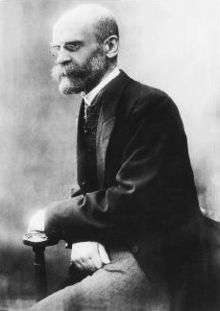The Elementary Forms of the Religious Life
The Elementary Forms of Religious Life (French: Les formes élémentaires de la vie religieuse), published by French sociologist Émile Durkheim in 1912, is a book that analyzes religion as a social phenomenon. Durkheim attributes the development of religion to the emotional security attained through communal living.
According to Durkheim, early humans associated such feelings not only with one another, but as well with objects in their environment. This, Durkheim believed, led to the ascription of human sentiments and superhuman powers to these objects, in turn leading to totemism. The essence of religion, Durkheim finds, is the concept of the sacred, that being the only phenomenon which unites all religions. "A religion," writes Durkheim, "is a unified system of beliefs and practices relative to sacred things, that is to say, things set apart and forbidden—beliefs and practices which unite into a single moral community called a Church, all those who adhere to them."[1] In modern societies, the individual and individual rights evolve to become the new sacred phenomena, and hence these may be called "religious" for Durkheim.
Durkheim examined religion using such examples as Pueblo Indian rain dances, the religions of aboriginal tribes in Australia, and alcoholic hallucinations.
See also
- The Division of Labour in Society (1893)
- Rules of the Sociological Method (1895)
- Suicide (1897)
References
- ↑ The Elementary Forms of the Religious Life (1915): Translated by Joseph Ward Swain, p. 47
Further reading
- Elementary Forms of the Religious Life: Newly Translated By Karen E. Fields. ISBN 0-02-907937-3
- The Elementary Forms of Religious Life (Oxford World's Classics): Translated by Carol Cosman. ISBN 0-19-954012-8
- Inglis, David and Roland Robertson. 2008. "The Elementary Forms of Globality:
Durkheim on the Emergence and Nature of Global Life." Journal of Classical Sociology 8:1, 5-25
- Lukes, Steven. 1972. Émile Durkheim, His Life and Work: A Historical and Critical
Study. London: Allen Lane and the Penguin Press.
- Andrew Mckinnon (2014). 'Elementary Forms of the Metaphorical Life: Tropes at Work in Durkheim’s Theory of the Religious'. Journal of Classical Sociology, vol 14, no. 2, pp. 203-221 .
- Pickering, W. S. F. 1984. Durkheim's Sociology of Religion: Themes and Theories.
London, Routledge and Kegan Paul.
- Strenski, Ivan. 2006. The New Durkheim New Brunswick: Rutgers University Press
.svg.png)
